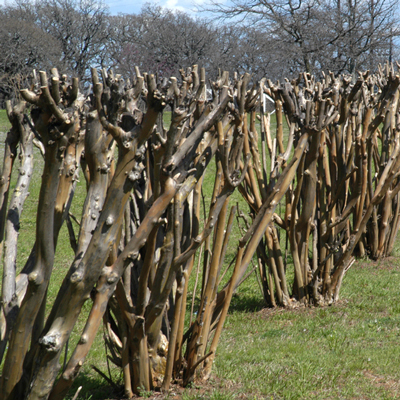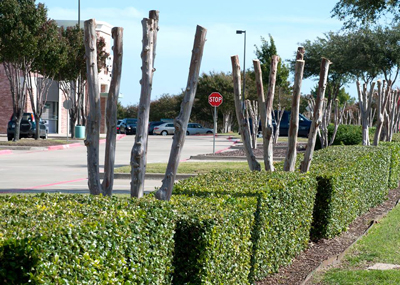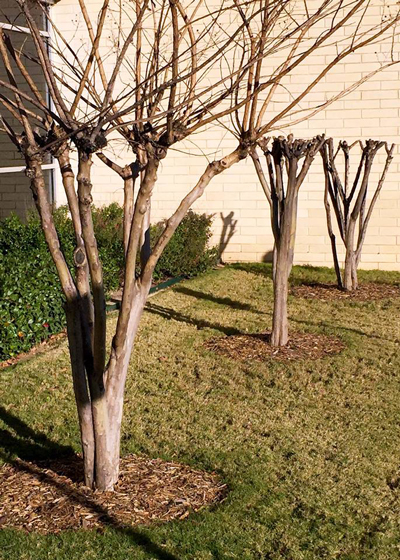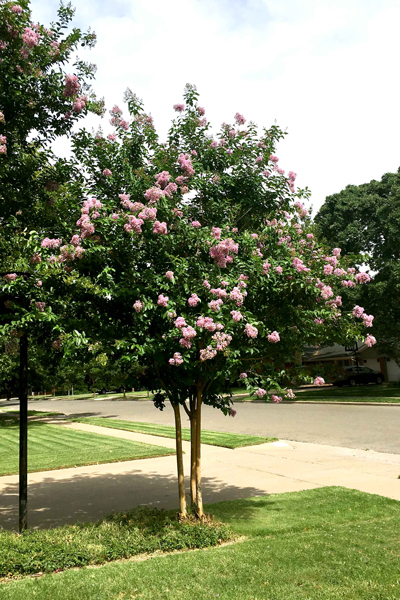Please, Texas! Stop Topping!
Crape myrtles are the shining summer stars of the South – until we start butchering them with barbaric topping. I just do not get it.

Some of the excuses I’ve heard…
Over the 50 years that I’ve been preaching this sermon these are some of the arguments people have spewed out. And I’m going to inject my own comments behind them.
• My plant was getting too tall. Then you planted the wrong variety. With more than 125 varieties on the market today, and with their mature heights ranging from 2 to 32 feet at maturity, there’s a crape myrtle of every size for every space. If you have a plant that’s too large, either move or re-move it. Replace it with something more appropriate.
• Topping makes my plant bloom better. That’s just not the case. Research from the University of Florida found that plants that had been topped bloomed six to eight weeks later each summer. That amounts to one or two lost rounds of blooms. Plants that have been topped usually bloom only one time. Plants that have not been whacked usually bloom two or three times every summer.
• Topping gives me bigger flower heads that are showier. Yes, it does. But the little branches that bear them are so long and supple that they can’t support them. They flop over to the ground ruining the plants’ normal shape.
• Everybody else does it. Well, now there’s the best reason of all. That’s a great place to rest my case.

What I once suggested…
I used to advise people who wanted to remove the spent seedheads over the winter that they could prune any twig smaller than a pencil in diameter. That would let them get rid of the seedheads and “clean up their plants.” It seemed to offer some sort of therapeutic relief for those obsessed with pruning crape myrtles.
But then I watched a neighbor start to do this. He didn’t know I was watching. He followed the guidelines for a few branches, but it was obvious that he was getting bored. He figured he could cut lower, remove a bigger part of each branch in one more massive whack and get back to the ball game a whole lot more quickly. Soon his plant was whacked and ruined forever.
Crape myrtles are sub-tropical plants. Those old seedheads and the twigs on which they were produced freeze. They’re dried and brittle. They’re all going to fall off by May anyway as new growth is produced this spring. Leave them alone.
And that is why, for the past 15 or 20 years, I’ve dialed it all way back. I advise people never to prune anything off the tops of crape myrtles. (Unless it’s a misplaced branch that needs to be removed flush with the main trunk without leaving a stub.)

What to do with a plant that’s been butchered…
If you’ve moved into a home where the previous owner didn’t know any better than to top the crape myrtles, how can you get them back to their rightful glory?
You might be amazed. Mark Byers of Byers Wholesale Nursery in Alabama advised me almost 20 years ago that the best way is to cut them completely to the ground and retrain the vigorous sprouts they will send up in the spring. I should have known that, because that’s what I’d done with a couple of tender varieties that had frozen to the ground in bad winter cold spells, and they were back to being beautiful trees within 24 months.

I adopted that recommendation and it’s been amazing how many people have reported success in using it. It gives hope where there once was none. Pruning to redirect limb growth certainly didn’t work. Scars on the old trunks remain visible for decades. This cutting the topped trunks back to the ground really works.
Better yet, don’t ever top them at all.
